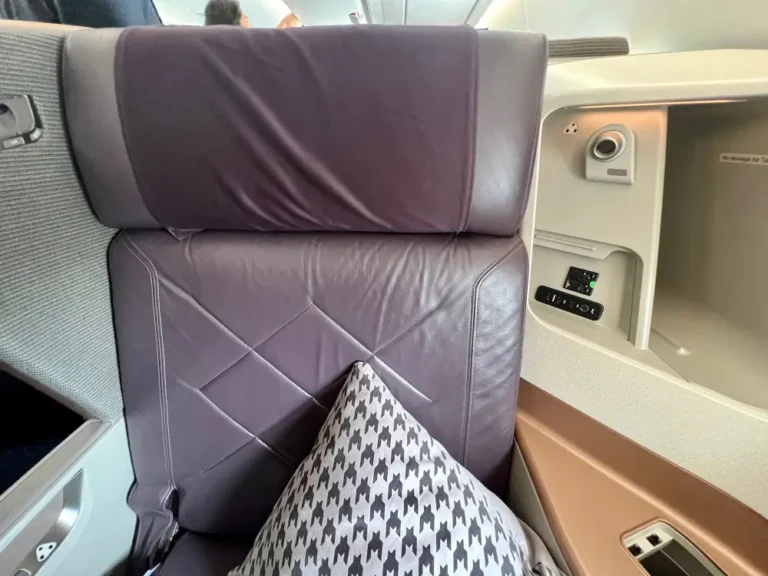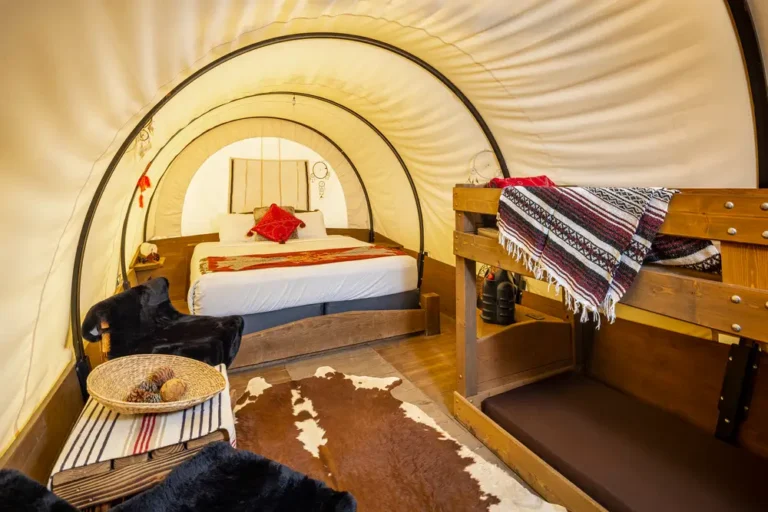I flew budget carrier Norse Atlantic Airways from Europe to New York. It’s a great value if you follow strict bag rules.
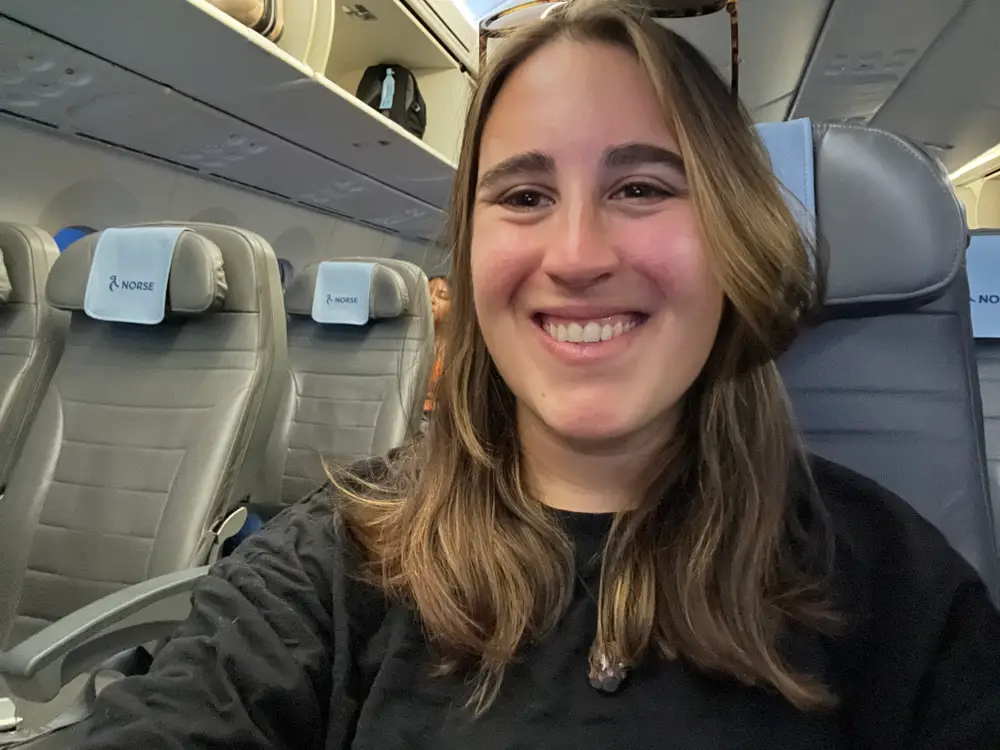
I enjoy flying on Norse Atlantic Airways and find its seat as good as mainline competitors.
In 2022, a new startup airline called Norse Atlantic Airways launched cheap flights between Europe and the US, operating Boeing 787 Dreamliners equipped only with economy and premium economy seats.
I was initially skeptical about the historically unsuccessful business model. Icelandic carrier WOW Air ceased operations in 2019, and Norway’s Norwegian Air Shuttle scrapped its transatlantic arm two years later.
But the travel addict in me was thrilled to learn about another budget option across the Atlantic — especially one that operates a wider network to Europe than competitors like Spain’s Level or Paris-based French Bee.
I’ve previously flown Norse’s economy cabin twice to New York, first from Paris in 2023 and more recently from London in mid-August. If you’re eyeing the cheap fare but have concerns, I think Norse is perfectly comfortable — just pay attention to the bag rules.
My recent Norse flight flew from London’s Gatwick Airport to New York’s John F. Kennedy International Airport.

Gatwick is not London’s Heathrow Airport.
I prefer flying from Gatwick to London’s giant Heathrow Airport because I find it less chaotic.
Norse has scheduled nonstop flights from Gatwick to New York, Las Vegas, Los Angeles, Miami, and Orlando in the US.
The mid-tier ‘Classic’ fare cost me about $600 one-way and included a personal item, a carry-on bag, a checked bag, and one meal.

Be aware that Norse isn’t always less expensive after you add bags. But it was cheaper on my day of travel.
The most basic economy tier only provides for a personal item, while the highest coach level gets the “Classic” perks, plus an assigned seat priority boarding, and a refundable ticket. I paid another $30 to secure an assigned aisle seat.
Other nonstop options, like JetBlue Airways and Delta Air Lines, were at least a few hundred dollars more, which makes sense considering it was peak season. Having flown Norse once already and found it enjoyable, it was an easy decision cost wise.
But Norse isn’t always the cheapest option once you add a bag. I recommend comparing with add-ons included before booking.
I rarely check a bag when flying because I don’t like to waste time on either end of the flight, but it didn’t matter at Gatwick.

The author’s luggage included a backpack as a personal item, an Away carry-on bag, and a Beis carry-on bag that expanded to checked luggage size.
This particular trip required me to take more than my normal carry-on and personal item combo, so I opted to check a bag even though it would add time to check before flying and collect it after landing.
However, Norse’s Gatwick operation does not offer an online check-in option and requires all passengers to get their documents checked manually by an agent at the airport — meaning I’d have to go to the ticket counter anyway.
Being forced to stand in line regardless of whether you have a checked bag is one of the pitfalls of Norse, and it was the reality of flying from Paris, too.
I arrived by 9 a.m. for my 1:05 p.m. flight, and the line was already dozens of people long.
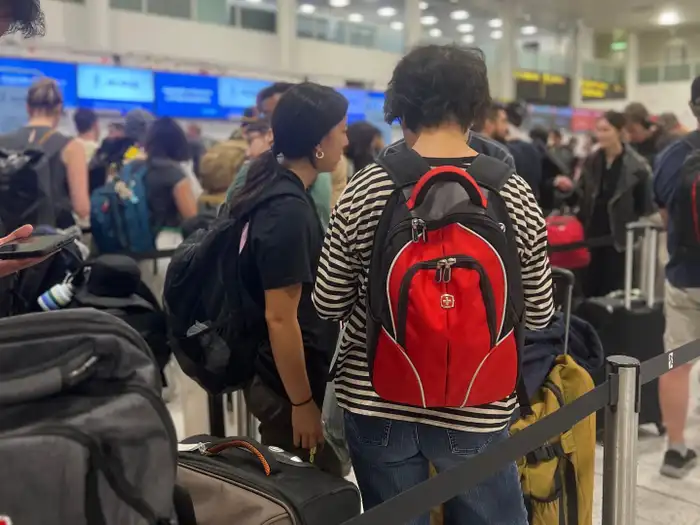
The line ahead of the author after joining the queue. Premium economy ticketholders can access an expedited line.
The bag check opened at 9:05 a.m. for New York-bound passengers.
The counter had several people working the desks, but the economy line still snaked beyond the queue barriers because people heading to Orlando and Los Angeles were also checking in.
I waited in line for about an hour.
The agent checked the weight and size of all of my luggage.

I had no issues with my bags’ size or weight, but that wasn’t the case for people around me.
One thing everyone needs to understand about flying on low-cost carriers — they make their profit from ancillary revenue, like bags, food, and seats. Bags are lucrative, with the world’s largest airlines securing an estimated $33 billion in luggage revenue in 2023.
Unsurprisingly, that makes airlines strict on the size and weight restrictions. I’ve seen customers pay hundreds at check-in for personal items that are actually the size of carry-ons, for example.
Norse clearly outlines its bag rules for passengers on its website and during booking.
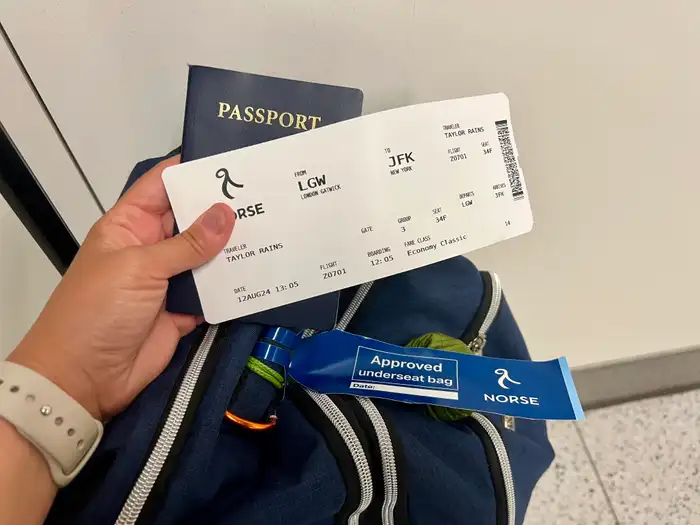
My luggage got an “approved” tag after it passed the weight and size check.
According to its website, a personal item can be a maximum of 15.5 x 11.5 x 5.5 inches with no weight limit, while carry-on bags can be a maximum size and weight of 22 x 18 x 10 inches and 22 pounds.
Premium economy travelers get a bigger personal item, which can be no larger than 17 x 14 x 8 inches. The carry-on size allowance is the same but can be up to 33 pounds.
Each allowed piece of standard checked luggage can be a maximum of 62 linear inches and 50 pounds in all cases. Norse’s website outlines the imposed fees of up to $300 — which applies per leg — if people show up to the airport with oversize, overweight, or unpaid bags.
After dropping off my luggage, I spent about 10 minutes clearing security before heading to the lounge. Boarding started around noon.
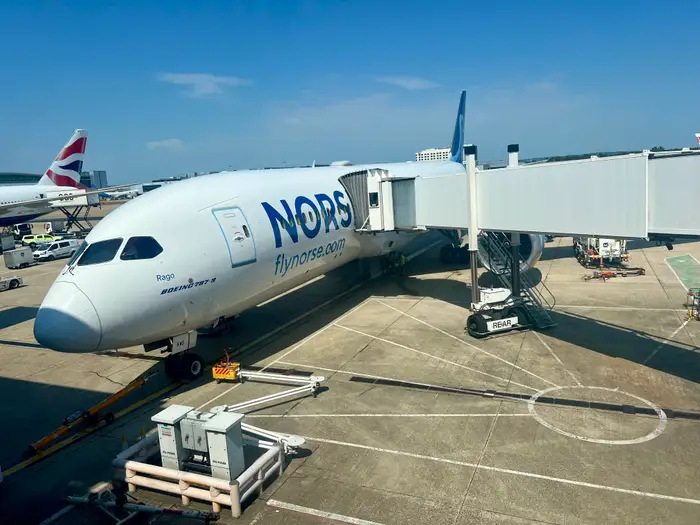
The Norse 787 at the Gatwick Airport gate.
Gatwick has several Priority Pass lounges, which I can access via my Chase Sapphire Reserve credit card. It costs $550 a year, but I find it is 100% worth it.
Gatwick’s lounges, however, are often full during peak season. While I could pre-book access for about $8, I put my name on the waitlist for No1 Lounge and got in about 45 minutes later.
I enjoyed what I came for — free breakfast and coffee away from the crowds and chaos of the terminal.
The airline currently operates seven Dreamliner aircraft equipped with 338 seats in two cabins. I paid $30 extra to sit in an aisle seat.
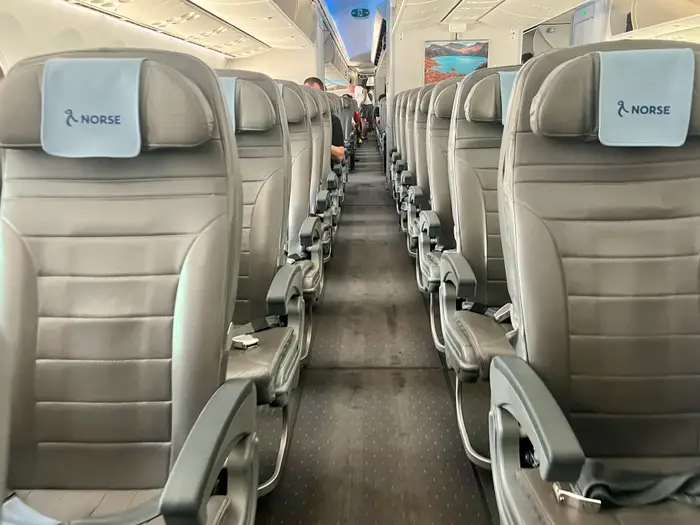
The regular economy seats on Norse’s 787.
According to Norse, its premium economy cabin has 56 seats in a 2 × 3 × 2 layout — meaning there is still a middle seat. Its regular coach cabin has 282 seats in a 3 × 3 × 3 configuration.
I almost always pay extra for an aisle seat because I like being able to go to the bathroom or stretch my legs at any time without disturbing my neighbor.
I also don’t like the tightness of the window seat, even if the view is better.I have not yet experienced premium economy, but I think Norse’s coach seats are easily competitive with mainline options.
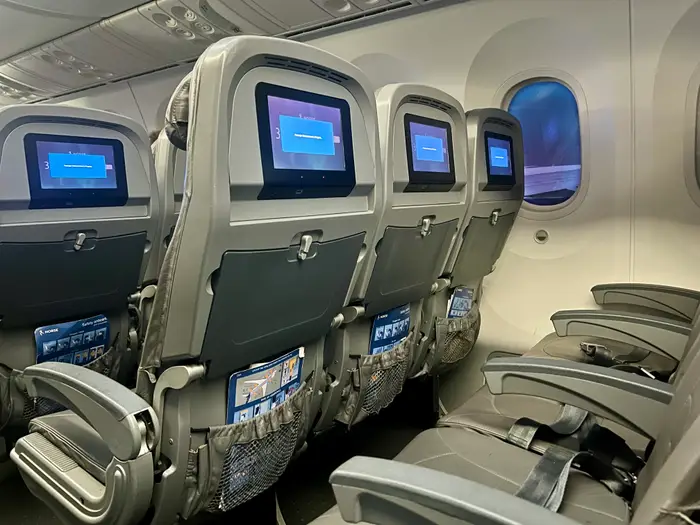
The Dreamliner plane had dimmable windows.
In the past two years, I’ve flown long-haul economy on American Airlines, Delta Air Lines, United Airlines, British Airways, Finnair, and Virgin Atlantic Airways, and Norse’s seats were easily comparable in terms of space and comfort.
In fact, the padding on Norse was noticeably better than the slimmer seats on many of the US’ Big 3 widebody planes. Norse seats also offer headrests and good recline to make sleeping easier.
Norse provides the standard 31 inches of seat pitch offered by competitors — so you won’t lose much legroom, if any, flying Norse.
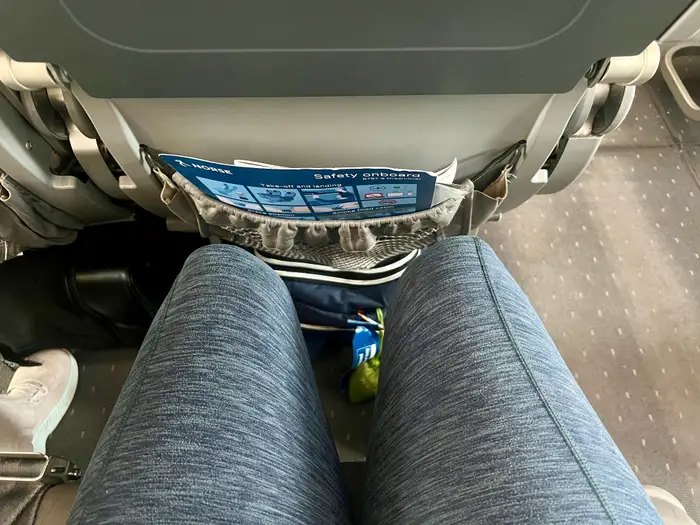
Norse and its competitors fall short of JetBlue Airways’ 32 inches of coach seat pitch.
I’m five feet and three inches tall, so I fit in practically any airline seat and found Norse perfectly spacious. The 17-inch seat width is a little narrow compared to mainlines, but not by much.
Taller travelers, however, may consider booking a bulkhead row seat for more legroom — that applies to the mainline airlines, too.
The seats also featured inflight entertainment screens, a power port, and a seatback pocket large enough for a water bottle.
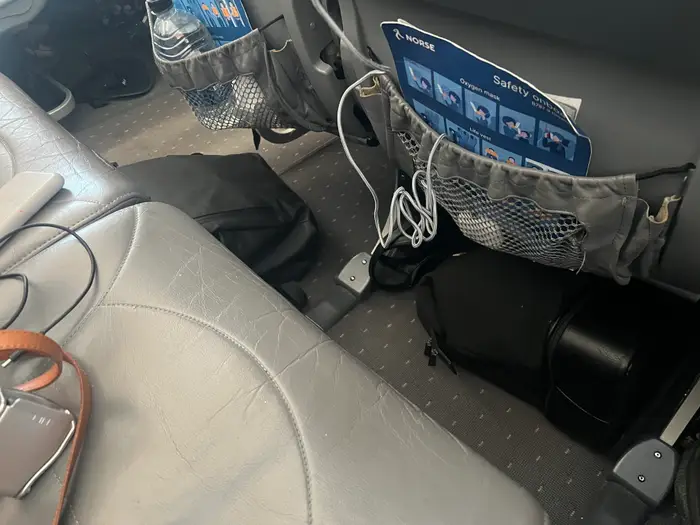
The space between the seats.
By comparison, the premium economy seats offer around 43 inches of pitch and 19.5 inches of width. Each also has a legrest and a footrest.
I can imagine sleeping would be made even easier in the bigger seats, but the minimum $310 to upgrade to premium economy for my flight wasn’t worth it, personally.
The entertainment screen is nice, but I recommend coming prepared with pre-downloaded content.

The IFE had movies like Harry Potter, both Dune movies, Crazy Rich Asians, and Ocean’s Thirteen.
I thought a fine selection of movies was available for the nearly eight-hour journey to New York, but I think passengers will find more (and newer) options on mainline carriers.
I always pre-download episodes of my favorite reality TV shows for when I fly. I watched a few Norse-provided movies too.
Remember to bring wired headphones — or Norse will charge you $6.50.

Pictured are the headphones I purchased on my first Norse flight from Paris to New York in 2023, but I remembered my own this time.
Bring your own wired headphones if you plan to use the seatback screen. Unlike mainline airlines, Norse charges for a set instead of giving it out for free — one of the many ways it makes ancillary revenue.
The same goes for linens. A “comfort kit” that comes with a blanket, a neck pillow, earbuds, and an eye mask costs $9, or you could request just a blanket for $6.50.
There is no WiFi and water costs $3.50.
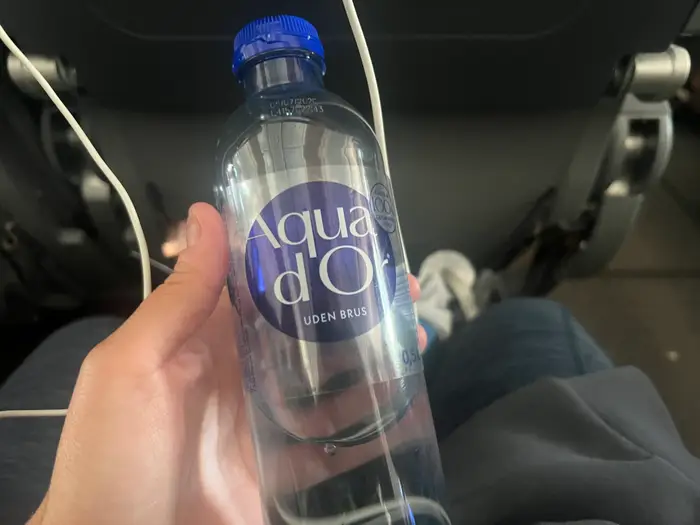
The $3.50 bottle of water.
Low-cost airlines primarily target the leisure flyer market, so WiFi is less of a priority. Forbes reported in June 2022 that many of Norse’s 787s have internet capabilities already installed, with plans to eventually activate the service.
WiFi is available on most other transatlantic carriers for a fee. The outliers are Delta and JetBlue, the former recently rolling out free internet on select international flights and the latter being famous for its fleet-wide free WiFi.
Only the one pre-booked meal was included in terms of snacks and drinks. I spent $3.50 on a bottle of water after mine ran out.
Once airborne, the flight attendants started service. My fare came with one pre-booked meal.
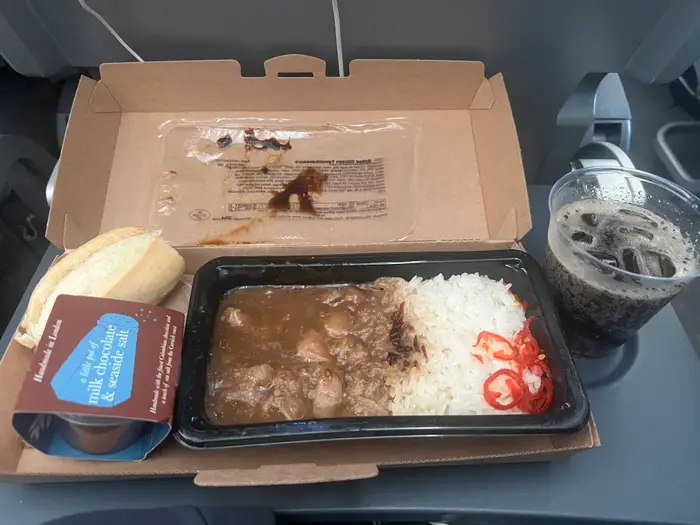
I opted for Coke Zero with my meal, but could choose from other sodas and juices.
I could choose between chicken teriyaki and a pasta dish. I went with the chicken, which came with bread, chocolate pudding, and a non-alcoholic drink.
The flavor and fullness made it easily one of the better meals I’ve had on an airplane. It was comparable to Delta but better than British Airways and United.
I will note that most mainline options provide two meals — one after takeoff and a lighter one before landing. I’d have to purchase the second one on Norse, but I found the one filled me enough until landing.
Passengers who didn’t pre-book a meal aren’t out of luck. The seatback screen has a marketplace to order food.

The flight attendants announced food was 50% off once we were about an hour and a half away from New York.
I was surprised to see hot meal options available to order from the seats. Travelers could select chicken green curry, vegan lasagna, pasta fusilli, or french fries.
There were also light meals and snacks, like tapas or Pringles, and alcohol for sale. The menu changes depending on the route, though.
After landing in New York, I only waited about 20 minutes for my checked bag.
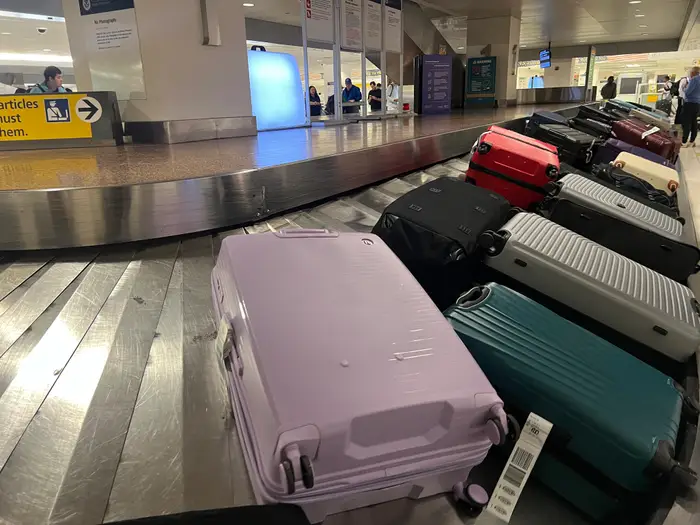
Last year, I waited 45 minutes for my checked bag after a Hawaiian flight from Honolulu.
For travelers connecting to another airline, you must clear customs, collect any checked luggage, and re-check it before clearing security.
Also, all of the terminals at New York-JFK are separate, so be mindful of connection times.
Flying Norse was enjoyable and I’d happily book again.

I think Norse is a competitive airline.
I’m not too high maintenance of a traveler, so I personally don’t see much of a difference comfort-wise between mainline airlines and Norse.
Low-cost competitor JetBlue may be more spacious, and Delta has the best customer service, but that’s not worth paying more for. I’m content so long as I have a roomy enough seat.
I can bring everything else — food, water, entertainment, and linens — myself. So I imagine similarly low-maintenance travelers would also be perfectly fine on Norse.
The main draw is the cheaper ticket, though I also like its network. That’s why I’d fly Norse but not most of its low-cost, long-haul competitors.
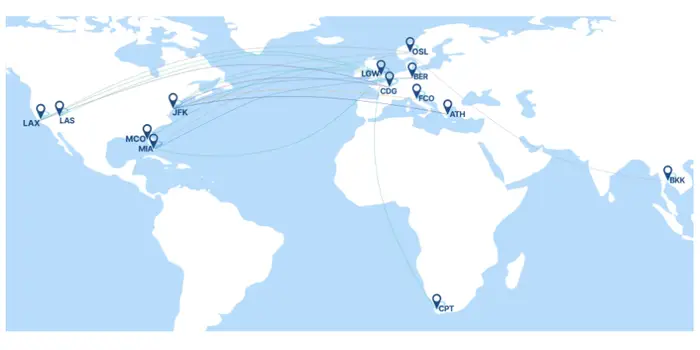
Norse flies as far as Bangkok and Cape Town, South Africa
Norse has smartly focused on point-to-point flying rather than shuttling people to European cities via a hub.
For example, I can fly nonstop from New York to London, Athens, Berlin, Oslo, Paris, and Rome. Only London is available from Orlando and Las Vegas, though Norse’s Miami and Los Angeles operations each offer three Europe routes.
By comparison, Iceland’s Play Airlines requires a stop in Reykjavik, while Spain’s Level flies via Barcelona, with onward flights on partners. French bee does the same as Level, but through its Paris-Orly Airport hub.
JetBlue is the closest budget competitor in terms of network, and it beats Norse in comfort, too. The US airline offers nonstop flights from the East Coast to London, Amsterdam, Paris, Dublin, and Edinburgh, Scotland.
The downside is that Norse is small and new, which means it has fewer options when things go wrong.
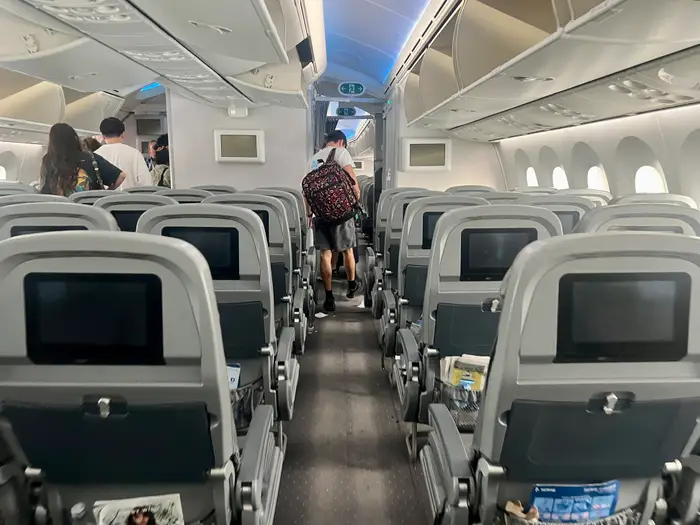
Passengers deplaning the Norse aircraft.
Norse doesn’t fly every route daily, so passengers could wait days for the system to catch up if a flight is canceled or severely delayed. Further, while it partners with other low-cost airlines for onward connections, Norse doesn’t have the same robust international agreements (or loyalty benefits, for that matter) as its mainline competitors.
Fortunately for Norse, monthly traffic data shows the airline completed 98% of flights in July — which is good considering the IT meltdown and the Olympics impacted its operation. However, its on-time performance was below the 80% industry standard outlined by travel data provider OAG.
Despite its limited operation, Norse is a good bang for your buck for price-sensitive travelers looking for an alternative to the more expensive mainline airlines — so long as you don’t show up with too much luggage.



